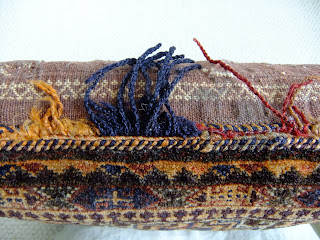My chosen piece for this exercise is a cushion cover.
It was handwoven in Afghanistan and was originally part of a traditional camel bag. These bags were used by nomadic tribes to carry their belongings and this cushion would have been made from one pannier of the bag. The fabric would be woven in a long piece with a central hole to throw over the hump, or in two pieces with a pannier either side. There are many beautiful designs for these bags, mostly geometric in design.
My cushion It is backed with a hardwearing fabric, also handwoven, probably a rough wool judging by the feel.
The front of the bag is woven with a cut pile so it feels like a tough velvet!
It had a fringe at some point in its history as there is some fringing left on one edge.
The stitching is clearly done by hand and appears to be a rough, strong yarn, again probably rough wool that wasn't suitable for spinning.
Older examples of these bags would have been handspun and naturally dyed as well as being handwoven. The fabric on the reverse of the bag has the more rustic look of a handspun warp and weft as there are slubs and colour variations I wouldn't expect to see in a commercially spun yarn. It is clearly finely woven as it has a beautiful, delicate woven border which would indicate a good quality piece (lesser quality pieces would be plain on the back to save time and cost).
There are corded edgings to the top and bottom, again suggesting a piece of fine quality.
The way the colour has aged on the back suggests natural dyes were used.
I would expect madder for the reds/orange/golds and browns, pomegranate for the buttery yellows. When viewed in good light there is some blue in the darker sections of the pattern, most likely indigo. For the black (which is very rich even after so many years) I would have to guess at walnut or a modified pomegranate, and over-dyed with indigo or maybe a local bark/plant? The most common black would be logwood overdyed with indigo but this would be the wrong part of the world for logwood which is mainly found in Central America.
As the practice of nomadic travel has declined (or as they are worn out/damaged), these bags are re-used and recycled. As well as adapting them into cushions and housewares for the Western market a common use is to find them slung over the back of a moped or motorcycle!
I particularly like this piece because of its rich history. It is beautiful but had a very practical purpose. The fact that it is clearly handmade and incorporates many of the techniques that I use in my own textiles today (handspinning, natural hand-dyeing and weaving) makes me feel a connection to the original makers. I love the idea that in all probability an entire family were involved in its production, with the men rearing and shearing the sheep, the children preparing the fleece, the women spinning the fleece into yarn and the men weaving the bag.
Sadly but unsurprisingly the lifestyle of nomadic peoples is under threat and the remaining nomadic tribes are struggling to retain their cultural traditions and in some cases, basic human rights. This site speaks a little of one such people.








